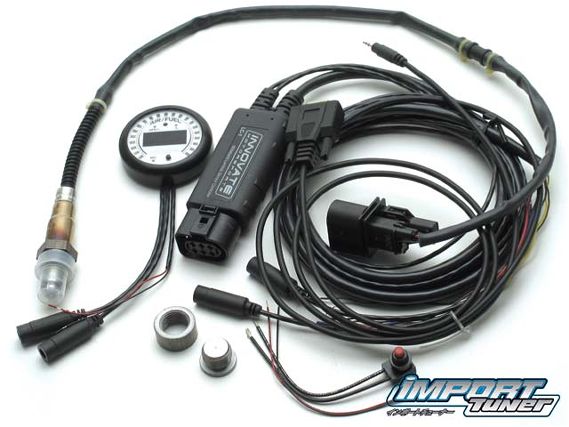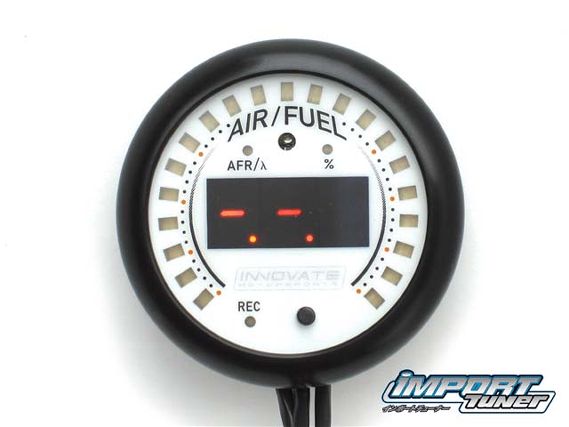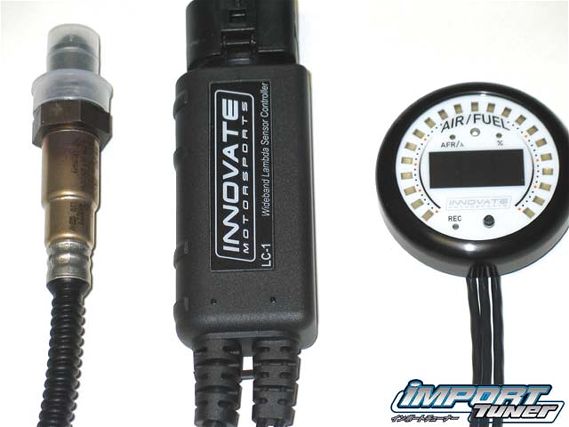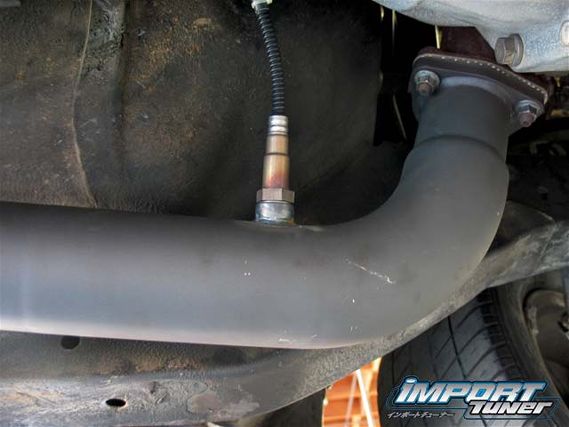 | Just released: Innovate Motorsports XD-1 display
| Just released: Innovate Motorsports XD-1 display
Driving a performance car is a lot like television commercials advocating parental involvement. "It's 10 p.m. Do you know where your children are?" Just as a parent should be involved in his or her child's life, we should be aware of our car's vital signs. Your car is most vulnerable to failure when you don't realize there's anything wrong. One of the most important details to monitor is your air/fuel ratio (AFR). If the mixture has too much fuel, it becomes rich, and the car will bog. If the mixture has too little fuel, it becomes lean, and your engine will knock, or worse, it will cause detonation. Then it's bye-bye motor.
A stock, narrow band oxygen sensor tries to keep the engine running as close to stoichometric (14.7:1) as possible. The wideband can measure a wider AFR range and is capable of giving you a precise ratio at any given rpm. This is especially important when tuning your high-performance application.
 | Just released: Innovate Motorsports XD-1 display
| Just released: Innovate Motorsports XD-1 display
Innovate Motorsports has engineered a modular system of tuning devices that includes air/fuel, multichannel auxiliary data logging and a compact standalone wideband controller system. The company's new XD-1 A/F display and LC-1 lambda cable with Bosch LSU 4.2 wideband O2 sensor are a clean, easy-to-use Universal Exhaust Gas Oxygen (UEGO) sensor and controller in a compact package. We're all looking for flexibility and information when we purchase gauges. This system is all that and more.
The XD-1 display features 21 LEDs that act as a digital needle and a 3-digit display in the center of the gauge. It is designed to be an A/F meter that can be used with Innovate's LM-1 digital wideband AFR meter or the new LC-1 lambda cable. The XD-1 can interface with the LM-1 for data logging and has a remote button that can calibrate the oxygen sensor or initiate data logging. The XD-1 is only .75 inch thick, so it is very easy to mount whether you elect to employ a traditional gauge pod or just surface-mount the gauge to your dash. In addition, the XD-1 can be programmed to display vitals from other sensors and display the reading from those sensors. The display face can be changed for any of these other functions and daisy chained together with other XD-1 displays to give you a uniformed array of gauges.
 | Just released: Innovate Motorsports XD-1 display
| Just released: Innovate Motorsports XD-1 display
The LC-1 lambda cable is a UEGO controller all in one compact cable. It can be used with the LM-1 for data logging and monitoring and it can also stand alone with the XD-1 display as a compact AFR. The body of the lambda cable contains circuitry that was pioneered in the LM-1, enabling it to interpret the wideband signal in real time. There are auxiliary inputs and outputs, making it possible to install the LC-1 and a wideband O2 sensor in place of the stock, narrow band O2 sensor. With simple wiring, the factory ECU will be reading AFR from the wideband sensor.
We installed the wideband O2 sensor using the included bung and mounted it on the downpipe of our turbocharged SR20DET motor. It's recommended to "clock" the location of the bung to anywhere between 10 and 2 o'clock. In other words, be certain the bung is welded on the top part of the pipe. Condensation can gather at the bottom of the pipe and damage the O2 sensor. Also, since the safe temperature range is below 900 degrees Fahrenheit, it is recommended that the sensor be located as far from the turbo as possible, but before the catalytic converter. Because the catalytic converter changes the exhaust content, you'll want to have the sensor mounted before it to get the most accurate AFR measurement. The same applies for a normally aspirated motor: mount the sensor after the collector but before the catalytic converter
 | Just released: Innovate Motorsports XD-1 display
| Just released: Innovate Motorsports XD-1 display
After installing the O2 sensor, we secured the lambda cable to the chassis and routed the wires through the firewall and under the dash. Installation is straightforward, with amateur wiring skills necessary to get everything wired up and running. The lambda cable has connectors that give you the option of attaching any of the modular devices available from Innovate Motorsports. In our case, we're connecting the XD-1 display. The XD-1 has only two flying lead wires and two serial connectors. The flying lead wires power the display (you only need a fuse-protected 12-volt positive and a ground point.) The two serial connectors are for signal input and output from the wideband controller and the data-logging computer, respectively. You would also use the serial connectors to program and calibrate other XD-1 displays depending on what sensor these gauges are monitoring. The data logging feature is optional but a great tuning tool, as you can graph and compare the AFR vs. RPM and really fine-tune your engine. The O2 sensor samples fast enough to see individual ignition misses, which are logged as small lean spikes on the graph.
The instructions call for sensor calibration and then you're ready to roll. After powering up the display and lambda cable, we were able to calibrate the O2 sensor with the push of a button. With the Bosch LSU 4.2 wideband constantly sampling the exhaust, we were able to monitor our test vehicle on the dyno and safely tune it without wondering whether we had too much or too little fuel. Anyone serious about power and tuning will want to know about the car's vitals. Grab it, and get tuning!
